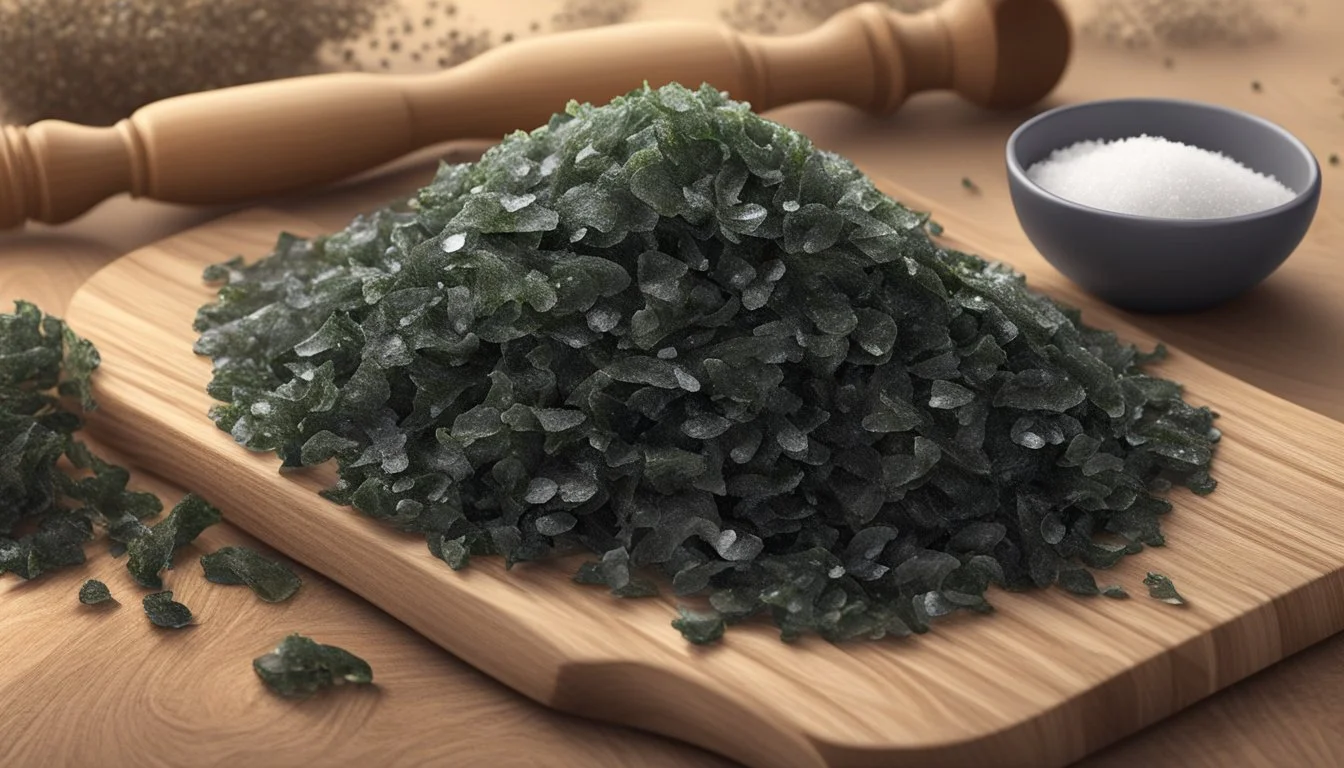Does Dried Seaweed Go Bad?
Shelf Life and Storage Tips
Dried seaweed, a nutritious and versatile ingredient, often raises questions about its longevity. Dried seaweed can last several months to a year or even longer when stored properly. This extended shelf life makes it an appealing pantry staple for many households.
Several factors influence the shelf life of dried seaweed. Proper storage conditions, such as keeping it in an airtight container and in a cool, dry place, play a crucial role in maintaining its quality. Additionally, the seaweed type and packaging conditions can affect how long it stays fresh and safe to consume.
Despite its long shelf life, dried seaweed can still go bad. Signs of deterioration include changes in color, texture, or smell. Paying attention to these indicators and the expiration date on the packaging ensures that you enjoy the best quality and nutritional benefits from your dried seaweed.
Understanding Dried Seaweed
Dried seaweed is an essential ingredient in many cultures and offers numerous health benefits. It is available in various types, each with unique characteristics, and can be used in an array of culinary dishes.
Types of Seaweed Commonly Dried
There are several types of seaweed frequently used in dried form:
Nori: Popular in Japanese cuisine, particularly for sushi.
Kombu: Used in broth and to enhance flavors through its natural umami.
Wakame: Commonly added to soups and salads.
Dulse: Known for its rich flavor and often used as a seasoning.
Laver: Typically found in Welsh and Korean dishes.
These varieties are abundant in nutrients and contribute unique textures and flavors to recipes.
Nutritional Benefits of Seaweed
Dried seaweed is packed with nutrients. It is rich in iodine, vital for thyroid health. It also provides iron and essential vitamins such as A, C, and E.
It's an excellent source of protein and contains numerous minerals that support a balanced diet. Regular consumption of seaweed can help cover gaps in one's diet, contributing to overall well-being.
Culinary Uses of Dried Seaweed
Dried seaweed's versatility makes it a staple in various cuisines. Nori is a key ingredient in sushi and can also be used as a garnish or snack. Kombu enhances the depth of soups and broths with its umami flavor. Wakame is often found in miso soup and seaweed salads.
Dulse and laver can be used to season rice dishes or incorporated into snacks. Whether in Japanese cuisine or used to add a savory note to Western dishes, dried seaweed adds both flavor and nutrition.
How to Identify Fresh and Quality Dried Seaweed
To ensure the best experience with dried seaweed, it's crucial to recognize the signs of quality and freshness. Key indicators include appearance, texture, aroma, and flavor. Learning to spot signs of spoilage such as discoloration, unpleasant odors, or changes in texture helps maintain health and taste standards.
Appearance and Texture Indicators
Fresh dried seaweed exhibits vibrant colors, typically green or black. Dull or faded colors may indicate age or poor quality. The texture should be crisp, crunchy, and slightly brittle to touch. Any dampness or stickiness suggests improper storage or spoilage.
Inspect the seaweed for uniformity in color and the absence of discoloration or spots. These are important visual cues for identifying quality products.
Recognizing Freshness by Flavor and Aroma
High-quality dried seaweed has a fresh, oceanic aroma, reminiscent of the sea. The flavor is robust and umami-rich. There should be no unpleasant odors like mustiness or sourness, which indicate spoilage.
Taste a small piece to check its flavor profile. Fresh seaweed is typically flavorful and free of off-tastes. This ensures the product has been stored and handled correctly.
Signs of Spoilage in Dried Seaweed
Spoilt dried seaweed can be identified by several signs. Discoloration, such as brown or yellow patches, often points to degradation. An unpleasant odor is another strong indicator of spoilage, signaling that the seaweed has absorbed moisture or contaminants.
Presence of mold is a definitive sign of spoilage. Always check for these signs to avoid consuming compromised seaweed. Proper storage is essential to prolong its shelf life, keeping it crisp, fresh, and safe for consumption.
Proper Storage Conditions for Dried Seaweed
Proper storage of dried seaweed ensures its longevity and preserves its quality. Key points include maintaining a cool, dry environment and using airtight containers.
Ideal Temperature and Humidity
Dried seaweed should be stored in a cool, dry place to maintain its freshness. The ideal temperature ranges from 50°F to 70°F (10°C to 21°C). Avoid exposure to high humidity levels, as moisture can cause the seaweed to become damp and lose its texture and flavor. A humidity level below 60% is preferable.
Choosing Suitable Containers
Using the right containers helps protect dried seaweed from moisture and other environmental factors. Airtight containers such as glass jars or resealable plastic bags are excellent options. These containers prevent air and moisture from entering, ensuring the seaweed remains crisp and flavorful.
Maximizing Shelf Life in Different Environments
Different storage environments can affect the shelf life of dried seaweed.
Pantry: When stored in a pantry, dried seaweed can last between 6 to 12 months. Ensure it is kept in an airtight container away from direct sunlight and moisture.
Refrigerator: Storing dried seaweed in the refrigerator can extend its shelf life to 12 to 18 months. It’s important to keep it in airtight containers to protect against humidity.
Freezer: For the longest shelf life, dried seaweed can be stored in the freezer for up to 2 years. Seal it properly to prevent freezer burn and moisture accumulation.
By following these guidelines, you can maximize the shelf life of dried seaweed and maintain its quality.
Determining the Shelf Life of Dried Seaweed
Dried seaweed can last for varying periods depending on storage conditions and specific product details. Understanding expiration dates and typical shelf life can help consumers maintain freshness and ensure their seaweed is safe to consume.
Deciphering Expiration and Best By Dates
Most dried seaweed products come with a "best by" date rather than a strict expiration date. This date indicates when the product is expected to achieve its peak freshness and flavor.
It's essential to store seaweed in a cool, dry place, away from light and moisture to maintain its quality. While it may still be safe to consume dried seaweed after the "best by" date, its taste and nutritional value might diminish.
Vacuum sealing or using airtight containers can extend the product's shelf life. Keeping these factors in mind helps determine if dried seaweed is safe and palatable beyond its labeled date.
How Long Does Dried Seaweed Typically Last?
Typically, dried seaweed lasts 6 to 12 months when stored in the pantry. Proper storage can extend this to 12 to 18 months in the refrigerator.
In the freezer, dried seaweed can retain its quality for up to two years. Nori, a popular form of dried seaweed, can last between two to three years under ideal conditions.
Despite these extended periods, always check for signs of spoilage such as changes in color, texture, or smell before consuming. Properly stored dried seaweed can safely enhance meals with its unique flavor and benefits for a considerable period.
Safety and Health Considerations
Understanding the safety and health considerations of consuming dried seaweed is crucial. Spoiled seaweed can pose several risks, and dietary restrictions may affect its suitability for some individuals.
Risk Factors Associated with Spoiled Seaweed
Detecting spoilage in dried seaweed is essential for food safety. Spoiled seaweed may become moldy, overly brittle, or develop a strong unpleasant odor. These physical signs indicate that the seaweed should not be consumed due to potential health risks.
Bitterness in taste can also signify spoilage. Seaweed should have a mild, pleasant taste; a strong bitter flavor suggests it has gone bad. Consuming spoiled seaweed can lead to digestive issues and negatively impact overall health.
Proper storage is vital. Keeping dried seaweed in airtight containers, away from moisture and direct sunlight, can extend its shelf life and prevent spoilage.
Consuming Seaweed with Dietary Restrictions
Dried seaweed is a nutritious food, rich in calcium and other minerals. However, individuals with dietary restrictions should exercise caution. Those with soy allergies must watch for seaweed products flavored with soy sauce.
People on a low-sodium diet should be mindful, as some seaweed products may have added salt. Moreover, certain conditions like thyroid disorders may require moderated seaweed consumption due to its iodine content.
Despite its nutritional benefits, incorporating seaweed into a balanced diet requires awareness of potential allergens and dietary needs. Always check labels and opt for plain, unflavored seaweed if necessary to avoid unwanted ingredients.
Tips for Extending the Life of Dried Seaweed
Proper storage and handling can significantly extend the shelf life of dried seaweed. Focusing on moisture control and utilizing effective rehydration techniques are key methods.
Effective Use of Silica Gel and Desiccants
Silica gel packs and other desiccants can be crucial in maintaining the dryness of seaweed. When seaweed is exposed to moisture, it can become brittle and lose its nutritional value.
To prevent this, store it in an airtight container with silica gel packs. Silica gel absorbs moisture, helping to keep the seaweed dry and fresh longer. Place multiple packs if the container is large.
Make sure the container is kept in a cool, dark place, away from direct sunlight. Airtight containers limit exposure to air and humidity, which further preserves the seaweed’s quality.
Rehydrating and Reviving Dried Seaweed
Rehydrating dried seaweed involves soaking it in water, usually for about 5-10 minutes, depending on the type. The rehydration process restores the seaweed's texture and makes it suitable for consumption.
Use cold water to avoid affecting the seaweed's flavor. After soaking, drain and pat dry with a paper towel to remove excess water.
In some cases, adding a pinch of salt to the water can enhance the rehydration process. Avoid rehydrating more than needed at once, as it is best used fresh for optimal taste and nutritional benefit.







